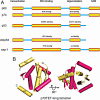One billion years of p53/p63/p73 evolution
- PMID: 19826090
- PMCID: PMC2764953
- DOI: 10.1073/pnas.0910634106
One billion years of p53/p63/p73 evolution
Conflict of interest statement
The authors declare no conflict of interest.
Figures

Comment on
-
Structural evolution of p53, p63, and p73: implication for heterotetramer formation.Proc Natl Acad Sci U S A. 2009 Oct 20;106(42):17705-10. doi: 10.1073/pnas.0905867106. Epub 2009 Oct 7. Proc Natl Acad Sci U S A. 2009. PMID: 19815500 Free PMC article.
References
-
- Vogelstein B, Lane D, Levine AJ. Surfing the p53 network. Nature. 2000;408:307–310. - PubMed
-
- Malkin D, et al. Germ line p53 mutations in a familial syndrome of breast cancer, sarcomas, and other neoplasms. Science. 1990;250:1233–1238. - PubMed
-
- Yang A, et al. p63 is essential for regenerative proliferation in limb, craniofacial and epithelial development. Nature. 1999;398:714–718. - PubMed
-
- Celli J, et al. Heterozygous germline mutations in the p53 homolog p63 are the cause of EEC syndrome. Cell. 1999;99:143–153. - PubMed
Publication types
MeSH terms
Substances
LinkOut - more resources
Full Text Sources
Research Materials
Miscellaneous

